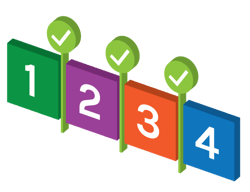The Stage-Gate methodology has become widely used since it was first introduced as a system in the 1980s. Many companies were using pieces of the puzzle already and found it both easy and exciting to have a system to follow and launch more products successfully. As with any industry, time brings innovation and changes that require methodologies to update and adapt to them. Does the stage gate process for product development remain strong after nearly forty years? Let's discuss the state of the Stage-Gate process and whether manufacturers should still use it.
What Is Stage-Gate Methodology
 The idea behind the Stage-Gate methodology in product development is that there are various gates the product plan must pass through before moving on to the next stage. At each gate is a test or approval process that the product must pass. This process should ensure that, come launch time, the product will be as successful as possible.
The idea behind the Stage-Gate methodology in product development is that there are various gates the product plan must pass through before moving on to the next stage. At each gate is a test or approval process that the product must pass. This process should ensure that, come launch time, the product will be as successful as possible.
The starting point is with research and a strong business case for the product or new variation on an existing product. The product team must gain approval on the plans from executives and finance before moving the product into the development portion.
Stage-Gate, as an official methodology, has several stages to follow and gates to approve before proceeding to the next stage. The end goal is always the same: launch a well-positioned model to succeed in the market. The main approval stages involved are as follows:
- Idea Generation
- Scoping
- Build a Business Case
- Development
- Testing and Validation
- Launch
Idea Generation
Idea generation is the point where ideas are formed and explored. In this stage, there could be a completely new product idea or a new version of an established product.
Scoping
In this stage, the product management team will explore the ideas to find the one worth pursuing. One popular method to test an idea's viability is the SWOT method,, which analyzes the strengths, weaknesses, opportunities, and threats. The ideas that score the highest on the scale are usually approved at this gate.
Build a Business Case
Once the product team chooses what to pursue, they will create several reports to help gain approval for the next stage. These reports may include a product definition, product analysis, business case, and a project plan. They will also conduct a feasibility review to present to executives and finance.
Development
When a product idea passes the first three stages, it is ready to move into development. The product manager(s) will have created a product roadmap and recruited a team to work on each stage of development. This base can take time, depending on the scope of the product. The product will move to the next approval gate only when a finished prototype is complete.
Testing and Validation
With a prototype in hand, the product teams will then test and validate their idea with internal testing teams, external test groups, and customer focus groups. Internal teams test for problems and flaws in the design or build. External groups and customer test groups use a beta prototype and either provide feedback or are observed by customer evaluation teams. It's at this stage that a marketing test and feasibility report is created.
Launch
If and only when the tested product is validated and approved, it then hits the launch stage. Production will go into full swing and will be shipped to the corresponding markets.
Why Change What's Already Working?
 For years, the Stage-Gate method has dominated the manufacturing sector because it worked. Now, many companies are so accustomed to spending time creating well-researched and tested products that they are wary about changing their systems. But with the pace of innovation today and the rapid release of less complex products and software, some manufacturers are rethinking their strategies.
For years, the Stage-Gate method has dominated the manufacturing sector because it worked. Now, many companies are so accustomed to spending time creating well-researched and tested products that they are wary about changing their systems. But with the pace of innovation today and the rapid release of less complex products and software, some manufacturers are rethinking their strategies.
While change may be difficult, it's not impossible. Most manufacturing companies who want to be more flexible in their product development process will adopt some Agile tactics with the Stage-Gate or Phase-Gate process. This combination is referred to as a hybrid approach.
How to Adapt to New Methods
 Stage-Gate has its benefits, but companies can no longer spend years researching, planning, and testing each new product in phases in industries with rapid innovation and impatient consumer demand.
Stage-Gate has its benefits, but companies can no longer spend years researching, planning, and testing each new product in phases in industries with rapid innovation and impatient consumer demand.
The rapid increase of software integrated with hardware also requires faster adaptation that traditional Stage-Gate strategies alone cannot compete with. Overall, there are three main limitations to the Stage-Gate methodology that companies need to address to stay competitive.
Shorter Timelines
One of the biggest limitations of the Stage-Gate approach is the time it takes between each gate and a tangible working prototype or a clear view of what the solution is and whether it meets the needs of the market. To stay competitive, companies need to shorten the time between idea and launch. Taking a hybrid approach where possible can help speed up those timelines.
Creating an MVP
Creating a minimum viable product (or MVP) gives a company something to launch, test, and get feedback on to improve the product's next iteration. Depending on the complexity, sometimes an MVP can be a basic product that can be sold to customers before introducing the next version with more exciting features.
In other cases, an MVP might be a digital rendering that testers and customers can interact with and provide feedback. For example, it's not realistic to expect a company to launch a physical MVP of an innovative tractor design. They can present a group of farmers with a prototype design, show them the specs, and ask for their feedback to incorporate during the design-and-build process rather than waiting until the end.
In an age where customers change their desires frequently and new technology constantly advances, it's necessary to have flexible, rapid strategies.
Increasing the Flow and Reducing Idle Times
Most Stage-Gate organizations organize themselves as a matrix where a pool of resources will be assigned to projects and then dismantled back the pools or phased in and out of the pool to keep the project lean in cost. This type of organization would spend time negotiating resources for each project and securing budget accordingly project by project. When resources are no longer available, for example when there is an issue in design but the design phase has been completed months in advance, the project will have to negotiate the resource back from the pool which is also inefficient. Finally teams that tend to form and dismantle, rarely have the chance to become an actual team and that can cause quality issues or slow progress towards creating team synergy.
Most organizations that move away from Stage-Gate or use a hybrid, focus on creating teams that take on one project or major product enhancements or new product initiatives one after the other without being dismantled. They align themselves either against the product line or market value (value streams) which reduce idle times and increases flow.
Manage Financial Loses
When using the Stage-Gate approach, if a mistake is made in the initial market research, the launch can be a disaster, causing the company to lose lots of money spent over a long period in the product development phase. With an MVP, you can test the product sooner and make adjustments to ensure the launch is successful.
Should Companies Stick With Stage-Gate / Phase-Gate?
 The Phase-Gate methodology still works. However, companies should realize that they can adapt their method to work for them. If a flexible version of Stage-Gate works, then companies can keep using it. However manufacturers that are adopting new technologies, including software, into the hardware portion of their products will have no choice but to increase a hybrid method to keep their teams aligned and their complex products on track.
The Phase-Gate methodology still works. However, companies should realize that they can adapt their method to work for them. If a flexible version of Stage-Gate works, then companies can keep using it. However manufacturers that are adopting new technologies, including software, into the hardware portion of their products will have no choice but to increase a hybrid method to keep their teams aligned and their complex products on track.
We're not here to advocate for one method or the other. All strategies are good if they are intentional and fit the needs of your product teams.
Product Roadmap Management Tools for All Methods
Here at Gocious, our mission is to provide product managers with software that helps them create great products. Book a live demo to see the benefits of our software.


